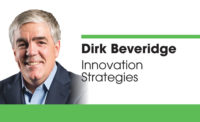Dirk Beveridge: Surviving the inflection point

By definition, an inflection point is an event that results in significant change when it comes to the progress of a company or an industry. The dramatic change caused by this turning point can be either positive or negative.
The distribution industry is currently at an inflection point. When I talk to distributors about the concept of transformative leadership and when I listen to distributors talk about creating sustainable businesses, what I hear is not only do they sense the need for change, but many also recognize it’s a survival issue. One CEO said to me, “Dirk, our current economic model is not sustainable to maintain pace with companies like Amazon.” Another told me, “If we don’t change, if we don’t find a way to get it done, the status quo of low net returns won’t allow us to invest in the organization at the desired or even the required rate.”
I don’t use the word “survival” flippantly. When I pose this question — if it’s really a survival issue — to any group of leaders, owners and CEOs working in distribution, the answer invariably comes back that it is an issue of survival.
The next questions I usually ask next are, “How fast is the change coming? What’s the pace of this disruption? How quickly can a new definition of relevancy and sustainability be created?” Based on the responses I get back, I’ve found there are two schools of thought. The first is the “School of Armageddon.” The other I refer to as the “School of Main Street America.” Depending on which school you subscribe to, you’re likely to have a very different reaction and response to major changes.
Ask yourself the following questions: How fast is this change happening? Is this disruption defining new business models? How fast is technology truly going to change what our customers demand of us? And how fast is technology truly going to redefine value propositions throughout the marketplace?
Those all are conversations you need to have with yourself and maybe your team. They’re also questions without easy answers. It’s not something I or even futurists can answer for you; it’s something you have to decide for yourself.
School of Armageddon
The School of Armageddon has a relatively dire outlook. Its philosophy could be summed up as, “Innovate or perish.” This school recognizes an imperative to drive change, transformation and innovation in addition to rethinking value propositions and culture because it sees the industry as facing Armageddon. Believers hold the viewpoint that, “If we do nothing, it will destroy us.”
This school also views a growing gap in trust between distributors and suppliers as a growing danger, as it believes the gap will widen if left unaddressed. They believe everything is a matter of survival.
I’ve learned a great deal from Cisco over the years. John Chambers, the executive chairman and CEO of the company, had a particularly poignant insight when he told us we were about to see a major transition where technology finally has the ease of use and the integration that can really change the way we do business and impact everything from supply chain to customer interface to interacting with our peers.
Chambers went on to say that in this environment if we didn’t change and become a disruptive presence, we’d get left behind.
School of Main Street America
The School of Main Street America sees the loss of relevancy as a gradual process. I live in the town of Barrington, Illinois, 35 miles northwest of Chicago. It’s an amazing community. When you walk along Main Street in Barrington or in just about any other town in America, you’ll see shops still are open and customers still are shopping.
However, in most towns you visit, you’ll notice more vacancies. There are more stores that have closed and are waiting for the next shopkeeper. You’ll also find the store traffic in the remaining shops isn’t what it once was.
Main Street America has weathered quite a few changes over the years. A lot of people moved on to shopping at malls and, more recently, online shopping. Main Street America has been thoroughly disrupted in recent decades, but it’s still around. You still have some stores; it may not be as profitable as it used to be, but Main Street is hanging in there and commerce continues to get done.
The School of Main Street America is far less dire than the School of Armageddon. It tells us if we don’t change we’ll become less relevant over time. It’s a gradual decline rather than a sudden death. The Main Street mentality suggests making changes isn’t as imperative — and can be done more gradually — because the major disruption isn’t coming as quickly as the media claims. They believe they don’t need a total leap because they believe there’s still plenty of time.
I believe we’re currently facing inflection points and, to a large extent, it doesn’t matter if you take the Armageddon or Main Street approach because both paths require the same considerations.
Time to take charge
The need for transformative leadership couldn’t be clearer right now. There are tremendous changes happening — inflection points, the age of disruption, economic power shifts and so on — and most distributors feel their organizations aren’t keeping up. 72% of distributors believe the pace of change is too slow in their business. Some distribution CEOs believe less than 10% of distributors are preparing or are already prepared for the future. Many distributors I’ve talked to are concerned they aren’t learning as quickly as the world is changing and other CEOs recognize too much of the industry is using 50-year-old strategies. One CEO suggested the distribution industry is stuck in a time capsule where nothing changes.
Countless distributors recognize and agree the industry is at an inflection point and the need to change is imperative. When a few CEOs mentioned the idea that many distributors were dead in the water, I decided to do a little research. I found 58% of distributors believe many distribution companies already are out of business, but they don’t know it yet. Can you think of any distributors that might fit that category?
What about your company? Are you creating an environment of innovation, change and transformation in order to create that new definition of sustainability, relevancy and profitability that tomorrow is going to demand?
Looking for a reprint of this article?
From high-res PDFs to custom plaques, order your copy today!









